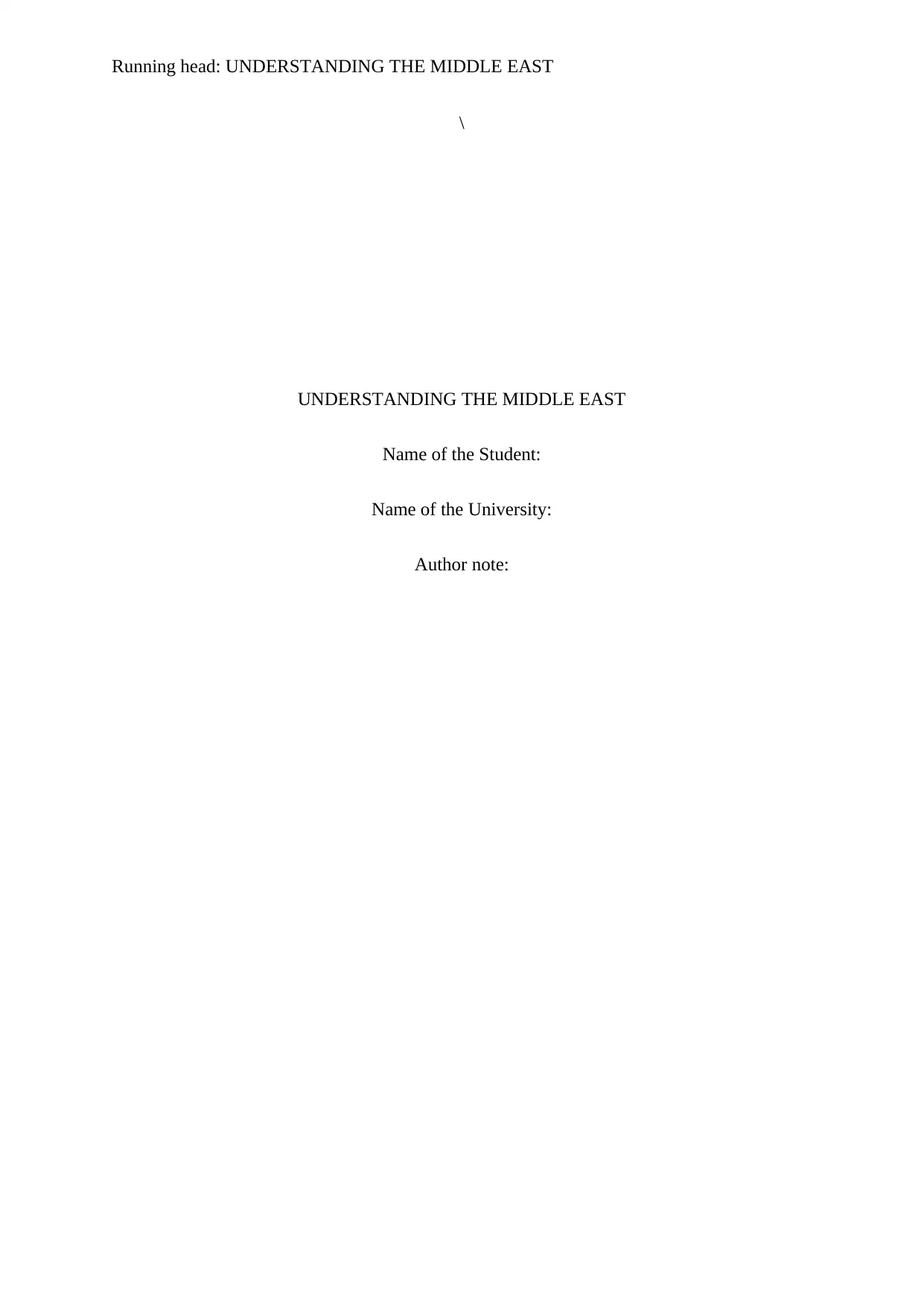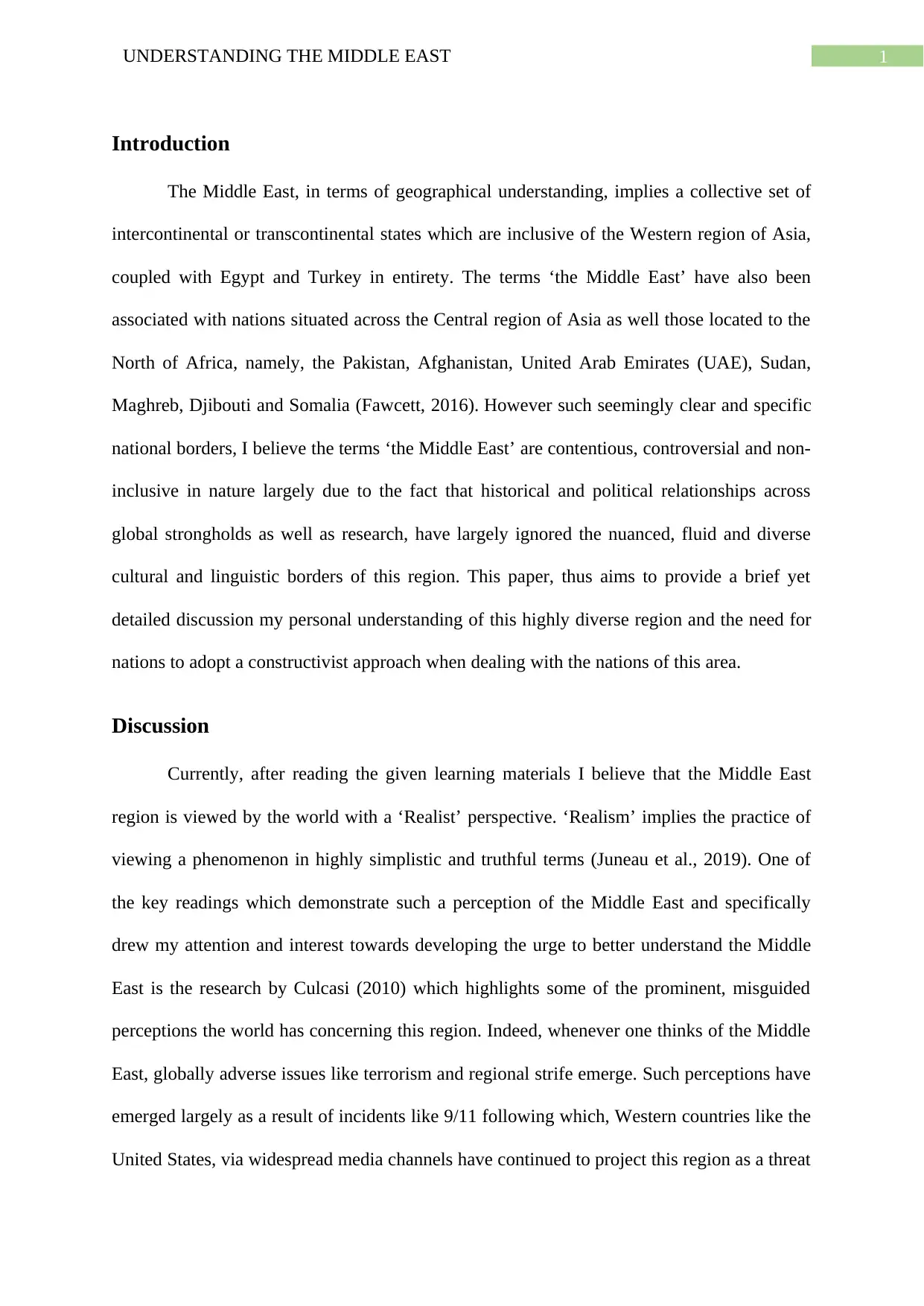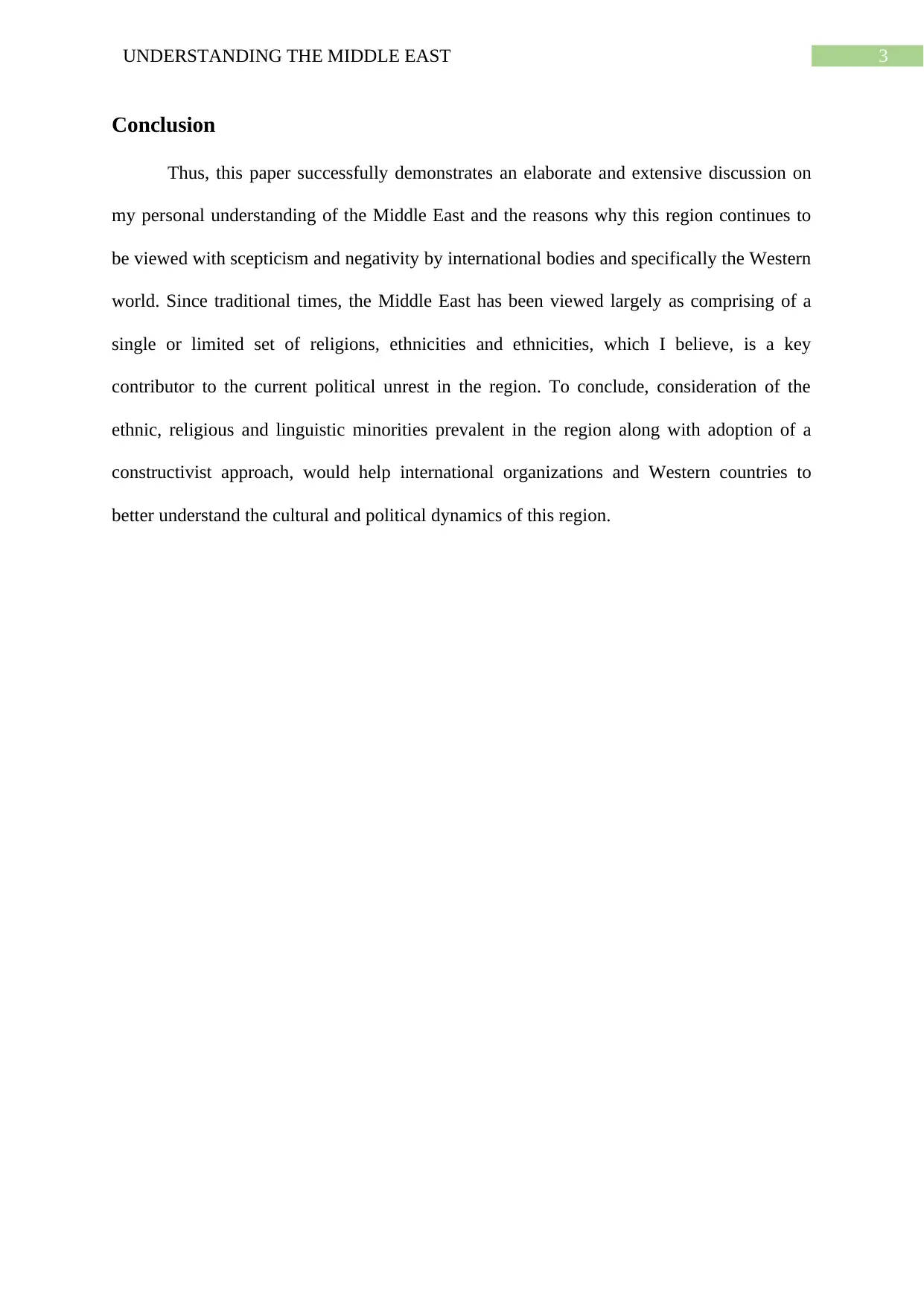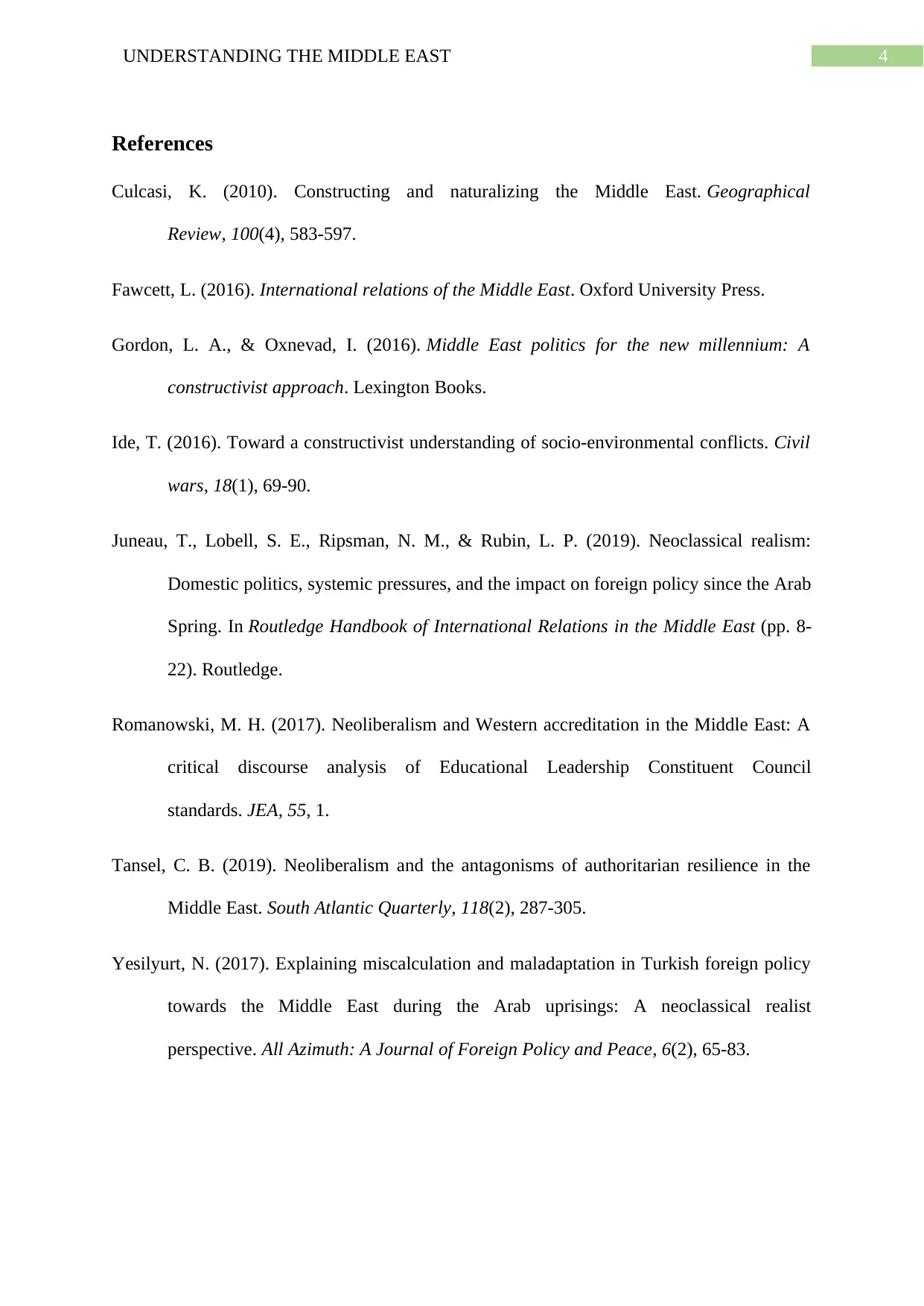University Essay: ANT-432 Module 1, Understanding the Middle East
VerifiedAdded on 2022/08/19
|5
|1135
|7
Essay
AI Summary
This essay delves into the complexities of the Middle East, examining how it is perceived through different lenses such as realism and neoliberalism, and advocating for a constructivist approach. The author argues that the region's diverse cultural, religious, and ethnic landscape is often oversimplif...

Running head: UNDERSTANDING THE MIDDLE EAST
\
UNDERSTANDING THE MIDDLE EAST
Name of the Student:
Name of the University:
Author note:
\
UNDERSTANDING THE MIDDLE EAST
Name of the Student:
Name of the University:
Author note:
Paraphrase This Document
Need a fresh take? Get an instant paraphrase of this document with our AI Paraphraser

1UNDERSTANDING THE MIDDLE EAST
Introduction
The Middle East, in terms of geographical understanding, implies a collective set of
intercontinental or transcontinental states which are inclusive of the Western region of Asia,
coupled with Egypt and Turkey in entirety. The terms ‘the Middle East’ have also been
associated with nations situated across the Central region of Asia as well those located to the
North of Africa, namely, the Pakistan, Afghanistan, United Arab Emirates (UAE), Sudan,
Maghreb, Djibouti and Somalia (Fawcett, 2016). However such seemingly clear and specific
national borders, I believe the terms ‘the Middle East’ are contentious, controversial and non-
inclusive in nature largely due to the fact that historical and political relationships across
global strongholds as well as research, have largely ignored the nuanced, fluid and diverse
cultural and linguistic borders of this region. This paper, thus aims to provide a brief yet
detailed discussion my personal understanding of this highly diverse region and the need for
nations to adopt a constructivist approach when dealing with the nations of this area.
Discussion
Currently, after reading the given learning materials I believe that the Middle East
region is viewed by the world with a ‘Realist’ perspective. ‘Realism’ implies the practice of
viewing a phenomenon in highly simplistic and truthful terms (Juneau et al., 2019). One of
the key readings which demonstrate such a perception of the Middle East and specifically
drew my attention and interest towards developing the urge to better understand the Middle
East is the research by Culcasi (2010) which highlights some of the prominent, misguided
perceptions the world has concerning this region. Indeed, whenever one thinks of the Middle
East, globally adverse issues like terrorism and regional strife emerge. Such perceptions have
emerged largely as a result of incidents like 9/11 following which, Western countries like the
United States, via widespread media channels have continued to project this region as a threat
Introduction
The Middle East, in terms of geographical understanding, implies a collective set of
intercontinental or transcontinental states which are inclusive of the Western region of Asia,
coupled with Egypt and Turkey in entirety. The terms ‘the Middle East’ have also been
associated with nations situated across the Central region of Asia as well those located to the
North of Africa, namely, the Pakistan, Afghanistan, United Arab Emirates (UAE), Sudan,
Maghreb, Djibouti and Somalia (Fawcett, 2016). However such seemingly clear and specific
national borders, I believe the terms ‘the Middle East’ are contentious, controversial and non-
inclusive in nature largely due to the fact that historical and political relationships across
global strongholds as well as research, have largely ignored the nuanced, fluid and diverse
cultural and linguistic borders of this region. This paper, thus aims to provide a brief yet
detailed discussion my personal understanding of this highly diverse region and the need for
nations to adopt a constructivist approach when dealing with the nations of this area.
Discussion
Currently, after reading the given learning materials I believe that the Middle East
region is viewed by the world with a ‘Realist’ perspective. ‘Realism’ implies the practice of
viewing a phenomenon in highly simplistic and truthful terms (Juneau et al., 2019). One of
the key readings which demonstrate such a perception of the Middle East and specifically
drew my attention and interest towards developing the urge to better understand the Middle
East is the research by Culcasi (2010) which highlights some of the prominent, misguided
perceptions the world has concerning this region. Indeed, whenever one thinks of the Middle
East, globally adverse issues like terrorism and regional strife emerge. Such perceptions have
emerged largely as a result of incidents like 9/11 following which, Western countries like the
United States, via widespread media channels have continued to project this region as a threat

2UNDERSTANDING THE MIDDLE EAST
to other international countries in the world. Not only does demonstrate a highly streamlined
perception of a region brimming with cultural and religious diversity, but it also paves the
way for global strongholds (like the United States) to feel the need to exercise their control
over the Middle East (Yesilyurt, 2017).
Additionally, I also believe that with current trends and emphasis towards
globalisation and multiculturalism, the Middle East has been viewed internationally with a
‘Neoliberalism’ perspective. Neoliberalism largely compels individuals and organisations to
view the viability of a region or nation in terms of price and trade decentralisation as well as
liberating the economic constructs of a country from a state (Tansel, 2019). Viewing the
Middle East with such a perspective, I believe, has largely compelled countries to ignore the
various ethnic, cultural and religious minorities in the region. Indeed, taking historical
examples of Western collaboration such as Europe and United States with the Ottoman
Empire and the mandate system established by the League of the Nations, the Middle East, is
generally perceived to comprise of majority and economically profitable countries like Egypt,
Turkey, Syria and Iraq. Such perceptions have resulted in minority ethnic, religious and
linguistic communities prevalent across the Gulf or Arabian Peninsula to be overlooked
(Romanowski, 2017).
As rightly evidenced by Gordon and Oxnevad (2016) one must view the Middle East
with a Constructivist approach – which relies on the idea that perception and knowledge are
reliant on unique personal experiences. Thus, with respect to the same, I believe that
countries must move beyond the perception that the Middle East is primarily and Arabic and
dominantly Muslim region. Viewing the region with a constructivist lens will assist nations to
collaborate harmoniously with majority and minority communities in the region and thus
pave the way for peace (Ide, 2016).
to other international countries in the world. Not only does demonstrate a highly streamlined
perception of a region brimming with cultural and religious diversity, but it also paves the
way for global strongholds (like the United States) to feel the need to exercise their control
over the Middle East (Yesilyurt, 2017).
Additionally, I also believe that with current trends and emphasis towards
globalisation and multiculturalism, the Middle East has been viewed internationally with a
‘Neoliberalism’ perspective. Neoliberalism largely compels individuals and organisations to
view the viability of a region or nation in terms of price and trade decentralisation as well as
liberating the economic constructs of a country from a state (Tansel, 2019). Viewing the
Middle East with such a perspective, I believe, has largely compelled countries to ignore the
various ethnic, cultural and religious minorities in the region. Indeed, taking historical
examples of Western collaboration such as Europe and United States with the Ottoman
Empire and the mandate system established by the League of the Nations, the Middle East, is
generally perceived to comprise of majority and economically profitable countries like Egypt,
Turkey, Syria and Iraq. Such perceptions have resulted in minority ethnic, religious and
linguistic communities prevalent across the Gulf or Arabian Peninsula to be overlooked
(Romanowski, 2017).
As rightly evidenced by Gordon and Oxnevad (2016) one must view the Middle East
with a Constructivist approach – which relies on the idea that perception and knowledge are
reliant on unique personal experiences. Thus, with respect to the same, I believe that
countries must move beyond the perception that the Middle East is primarily and Arabic and
dominantly Muslim region. Viewing the region with a constructivist lens will assist nations to
collaborate harmoniously with majority and minority communities in the region and thus
pave the way for peace (Ide, 2016).
You're viewing a preview
Unlock full access by subscribing today!

3UNDERSTANDING THE MIDDLE EAST
Conclusion
Thus, this paper successfully demonstrates an elaborate and extensive discussion on
my personal understanding of the Middle East and the reasons why this region continues to
be viewed with scepticism and negativity by international bodies and specifically the Western
world. Since traditional times, the Middle East has been viewed largely as comprising of a
single or limited set of religions, ethnicities and ethnicities, which I believe, is a key
contributor to the current political unrest in the region. To conclude, consideration of the
ethnic, religious and linguistic minorities prevalent in the region along with adoption of a
constructivist approach, would help international organizations and Western countries to
better understand the cultural and political dynamics of this region.
Conclusion
Thus, this paper successfully demonstrates an elaborate and extensive discussion on
my personal understanding of the Middle East and the reasons why this region continues to
be viewed with scepticism and negativity by international bodies and specifically the Western
world. Since traditional times, the Middle East has been viewed largely as comprising of a
single or limited set of religions, ethnicities and ethnicities, which I believe, is a key
contributor to the current political unrest in the region. To conclude, consideration of the
ethnic, religious and linguistic minorities prevalent in the region along with adoption of a
constructivist approach, would help international organizations and Western countries to
better understand the cultural and political dynamics of this region.
Paraphrase This Document
Need a fresh take? Get an instant paraphrase of this document with our AI Paraphraser

4UNDERSTANDING THE MIDDLE EAST
References
Culcasi, K. (2010). Constructing and naturalizing the Middle East. Geographical
Review, 100(4), 583-597.
Fawcett, L. (2016). International relations of the Middle East. Oxford University Press.
Gordon, L. A., & Oxnevad, I. (2016). Middle East politics for the new millennium: A
constructivist approach. Lexington Books.
Ide, T. (2016). Toward a constructivist understanding of socio-environmental conflicts. Civil
wars, 18(1), 69-90.
Juneau, T., Lobell, S. E., Ripsman, N. M., & Rubin, L. P. (2019). Neoclassical realism:
Domestic politics, systemic pressures, and the impact on foreign policy since the Arab
Spring. In Routledge Handbook of International Relations in the Middle East (pp. 8-
22). Routledge.
Romanowski, M. H. (2017). Neoliberalism and Western accreditation in the Middle East: A
critical discourse analysis of Educational Leadership Constituent Council
standards. JEA, 55, 1.
Tansel, C. B. (2019). Neoliberalism and the antagonisms of authoritarian resilience in the
Middle East. South Atlantic Quarterly, 118(2), 287-305.
Yesilyurt, N. (2017). Explaining miscalculation and maladaptation in Turkish foreign policy
towards the Middle East during the Arab uprisings: A neoclassical realist
perspective. All Azimuth: A Journal of Foreign Policy and Peace, 6(2), 65-83.
References
Culcasi, K. (2010). Constructing and naturalizing the Middle East. Geographical
Review, 100(4), 583-597.
Fawcett, L. (2016). International relations of the Middle East. Oxford University Press.
Gordon, L. A., & Oxnevad, I. (2016). Middle East politics for the new millennium: A
constructivist approach. Lexington Books.
Ide, T. (2016). Toward a constructivist understanding of socio-environmental conflicts. Civil
wars, 18(1), 69-90.
Juneau, T., Lobell, S. E., Ripsman, N. M., & Rubin, L. P. (2019). Neoclassical realism:
Domestic politics, systemic pressures, and the impact on foreign policy since the Arab
Spring. In Routledge Handbook of International Relations in the Middle East (pp. 8-
22). Routledge.
Romanowski, M. H. (2017). Neoliberalism and Western accreditation in the Middle East: A
critical discourse analysis of Educational Leadership Constituent Council
standards. JEA, 55, 1.
Tansel, C. B. (2019). Neoliberalism and the antagonisms of authoritarian resilience in the
Middle East. South Atlantic Quarterly, 118(2), 287-305.
Yesilyurt, N. (2017). Explaining miscalculation and maladaptation in Turkish foreign policy
towards the Middle East during the Arab uprisings: A neoclassical realist
perspective. All Azimuth: A Journal of Foreign Policy and Peace, 6(2), 65-83.
1 out of 5
Related Documents
Your All-in-One AI-Powered Toolkit for Academic Success.
+13062052269
info@desklib.com
Available 24*7 on WhatsApp / Email
![[object Object]](/_next/static/media/star-bottom.7253800d.svg)
Unlock your academic potential
© 2024 | Zucol Services PVT LTD | All rights reserved.




